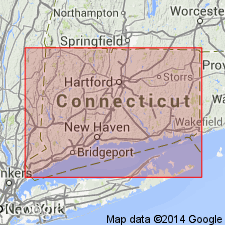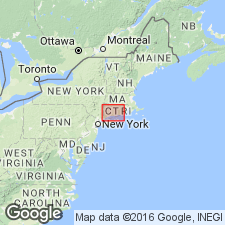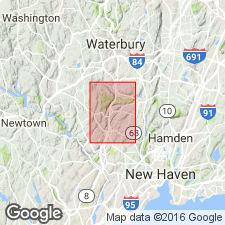
- Usage in publication:
-
- Orange phyllite
- Modifications:
-
- Original reference
- Dominant lithology:
-
- Slate or Phyllite
- AAPG geologic province:
-
- New England province
Summary:
Pg. 86, 101-102, and map. Orange phyllite. Slate or phyllite, highly fissile, sericitic, and usually dotted with minute garnets. Toward west, is much more micaceous, in places, approaching mica schist, and is also frequently feldspathic. Is minutely folded, contorted, and jointed. Beds of impure limestone or marble are interstratified at a number of places. The formation is believed to have been originally a shale, more or less calcareous. Present in western and western central Connecticut. In Orange and Woodbridge the formation is 6 miles wide. It lies between Prospect granite gneiss (Ordovician) and Triassic sandstone and shale. Age is pre-Triassic.
Source: US geologic names lexicon (USGS Bull. 896, p. 1555-1556).

- Usage in publication:
-
- Orange phyllite
- Modifications:
-
- Principal reference
- AAPG geologic province:
-
- New England province
Summary:
See also John Rodgers, R.M. Gates, and J.L. Rosenfeld, 1959, Explanatory text for preliminary geological map of Connecticut, Connecticut Geol. Nat. Hist. Survey Bull., no. 84, p. 14, 15, 36-37. Orange phyllite. Includes dark-gray lustrous phyllite or sericitic quartzite. Coarser toward the west where it is fine-grained mica-quartz-garnet schist. Beds of medium-crystalline micaceous limestone occur at several places. Few bodies of hornblende schist or amphibolite. Westernmost exposures probably Middle Ordovician. Origin of name stated.
Source: US geologic names lexicon (USGS Bull. 1200, p. 2843).

- Usage in publication:
-
- Orange phyllite
- Modifications:
-
- Revised
- Areal extent
- AAPG geologic province:
-
- New England province
Summary:
Pg. 12-14, pl. 1. Orange phyllite. Mica quartzites just east of Prospect gneiss, previously included in Orange phyllite, are here included in Hartland formation. Thus, Orange phyllite is restricted to rocks between Milford chlorite schist and Hartland formation.
[Misprint (USGS Bull. 1200, p. 2843): †Orange phyllite not abandoned.]
Source: US geologic names lexicon (USGS Bull. 1200, p. 2843).
For more information, please contact Nancy Stamm, Geologic Names Committee Secretary.
Asterisk (*) indicates published by U.S. Geological Survey authors.
"No current usage" (†) implies that a name has been abandoned or has fallen into disuse. Former usage and, if known, replacement name given in parentheses ( ).
Slash (/) indicates name conflicts with nomenclatural guidelines (CSN, 1933; ACSN, 1961, 1970; NACSN, 1983, 2005, 2021). May be explained within brackets ([ ]).

